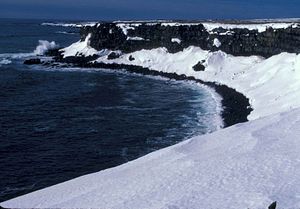On Wednesday, the Wall Street Journal reported that the U.S. Department of Defense, for the first time, had detected five Chinese People’s Liberation Army Navy (PLAN) ships in the Bering Sea, close to the Aleutian Islands. Though the Pentagon didn’t quite say what the ships were doing in the Bering Sea, the development is another notch in the Chinese navy’s “blue water” credentials. As the PLAN modernizes and expands, it is looking to operate in waters far away from the Chinese coastline, beyond the second island chain.
As the WSJ report notes, the ships were detected at a somewhat strange time. The Bering Sea is just west off the Alaskan coast. U.S. President Barack Obama just happens to have been visiting Alaska this week, marking the first visit by a U.S. president to that state’s territory above the Arctic circle. Putting two and two together, one might conclude that the PLAN is trying to “send a message” or flexing its muscles. But there’s nothing intrinsically threatening about its activities in international waters that just happen to be near Alaska. Even if these ships were involved in intelligence-gathering or reconnaissance activities, as long as they remained outside of U.S. territorial waters, there’s no real issue.
Fortunately, the Pentagon sees things this way and is sticking to its true-to-form policy of not opposing freedom of navigation of military assets in international waters. Indeed, the United States has made a policy of not calling out Chinese military activity within its exclusive economic zone (EEZ) as well. Some Diplomat readers may recall that when the Pentagon learned that China had spied on U.S. activities at the Rim of the Pacific (RIMPAC) 2014 exercise off the coast of Hawaii last year, the Pentagon reacted calmly. Admiral Samuel J. Locklear III, the commander of U.S. Pacific Command at the time, even welcomed China’s recognition of the fact that “military operations and survey operations in another country’s EEZs, where you have national — your own national security interest, are within international law and are acceptable.” So, it’s good to see that PLAN activity in the Bering Sea isn’t being blown out of proportion.
Regarding the question of how and why these PLAN vessels are in the Bering Sea, there are a range of anodyne explanations. First, as we’ve noted at The Diplomat recently, Russia and China have been carrying out naval drills in the Sea of Japan and off the coast of Russia’s Primorsky Krai region. It’s not as if PLAN vessels were nowhere near the area in recent days. It’s not inconceivable that PLAN ships would sail past the Kuril archipelago and the Kamchatka Peninsula to scout the Bering Sea. According to Xinhua, the Chinese vessels included “destroyers Shenyang and Taizhou, frigates Linyi and Hengyang, landing craft Changbaishan and Yunwushan and supply ship Taihu.” It’s unclear if these vessels immediately returned to port in China or sailed east toward the Bering Sea.
This explanation is speculative, of course, especially since the Pentagon hasn’t confirmed the precise location of the PLAN vessels or their proximity to the U.S. coastline. The move could also have to do with China’s growing interest in the Northwest Passage sea lanes leading into the fast-thawing Arctic Ocean. While there are certainly many outlying questions about why the PLAN is in the Bering Sea, what’s clear is that the Chinese Navy is familiarizing itself with new waters as it positions itself for expeditionary operations in the 21st century.

































